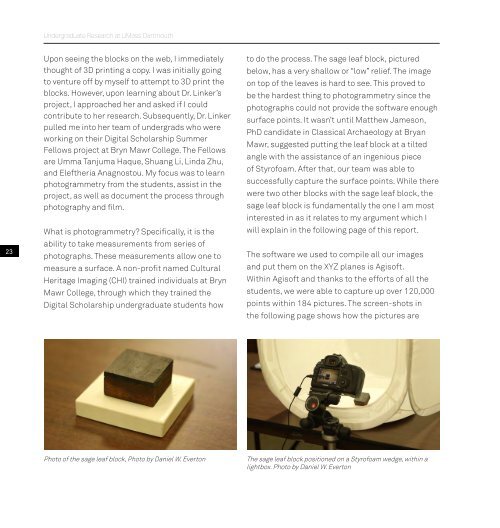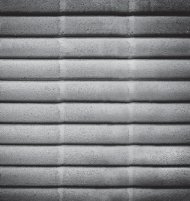Undergrad_Book_16-18_Pge_View_Print_no print marks_compressed
Create successful ePaper yourself
Turn your PDF publications into a flip-book with our unique Google optimized e-Paper software.
<strong>Undergrad</strong>uate Research at UMass Dartmouth<br />
23<br />
Upon seeing the blocks on the web, I immediately<br />
thought of 3D <strong>print</strong>ing a copy. I was initially going<br />
to venture off by myself to attempt to 3D <strong>print</strong> the<br />
blocks. However, upon learning about Dr. Linker’s<br />
project, I approached her and asked if I could<br />
contribute to her research. Subsequently, Dr. Linker<br />
pulled me into her team of undergrads who were<br />
working on their Digital Scholarship Summer<br />
Fellows project at Bryn Mawr College. The Fellows<br />
are Umma Tanjuma Haque, Shuang Li, Linda Zhu,<br />
and Eleftheria Anag<strong>no</strong>stou. My focus was to learn<br />
photogrammetry from the students, assist in the<br />
project, as well as document the process through<br />
photography and film.<br />
What is photogrammetry? Specifically, it is the<br />
ability to take measurements from series of<br />
photographs. These measurements allow one to<br />
measure a surface. A <strong>no</strong>n-profit named Cultural<br />
Heritage Imaging (CHI) trained individuals at Bryn<br />
Mawr College, through which they trained the<br />
Digital Scholarship undergraduate students how<br />
to do the process. The sage leaf block, pictured<br />
below, has a very shallow or “low” relief. The image<br />
on top of the leaves is hard to see. This proved to<br />
be the hardest thing to photogrammetry since the<br />
photographs could <strong>no</strong>t provide the software e<strong>no</strong>ugh<br />
surface points. It wasn’t until Matthew Jameson,<br />
PhD candidate in Classical Archaeology at Bryan<br />
Mawr, suggested putting the leaf block at a tilted<br />
angle with the assistance of an ingenious piece<br />
of Styrofoam. After that, our team was able to<br />
successfully capture the surface points. While there<br />
were two other blocks with the sage leaf block, the<br />
sage leaf block is fundamentally the one I am most<br />
interested in as it relates to my argument which I<br />
will explain in the following page of this report.<br />
The software we used to compile all our images<br />
and put them on the XYZ planes is Agisoft.<br />
Within Agisoft and thanks to the efforts of all the<br />
students, we were able to capture up over 120,000<br />
points within <strong>18</strong>4 pictures. The screen-shots in<br />
the following page shows how the pictures are<br />
Photo of the sage leaf block, Photo by Daniel W. Everton<br />
The sage leaf block positioned on a Styrofoam wedge, within a<br />
lightbox. Photo by Daniel W. Everton



